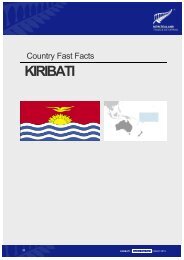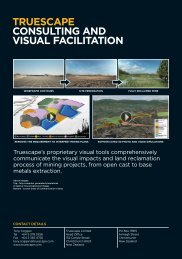Navigating China Guide (2012) - New Zealand Trade and Enterprise
Navigating China Guide (2012) - New Zealand Trade and Enterprise
Navigating China Guide (2012) - New Zealand Trade and Enterprise
Create successful ePaper yourself
Turn your PDF publications into a flip-book with our unique Google optimized e-Paper software.
3. ENTERING THE<br />
MARKET<br />
ENTRY MODES<br />
Non Equity<br />
Direct selling<br />
Appointing<br />
agent or<br />
distributor<br />
Forming an<br />
alliance<br />
Technology<br />
transfer<br />
Equity<br />
Representative<br />
office<br />
Wholly<br />
foreign owned<br />
enterprise<br />
Joint venture<br />
TIME, RESOURCES AND COMMITMENT<br />
This illustration is only indicative of the time <strong>and</strong> resources you will need to dedicate to a particular entry mode – these will vary case by case. Any decision on<br />
mode of entry needs to be based on a thorough underst<strong>and</strong>ing of the market.<br />
3.1 TYPICAL MODELS FOR SETTING UP<br />
IN CHINA<br />
Getting your presence in <strong>China</strong> right<br />
You need a local presence if you want to grow your business<br />
<strong>and</strong> have a long-term future in the Chinese market. Entering<br />
<strong>and</strong> setting up in this market involves a unique set of<br />
regulatory issues.<br />
The structure you choose should be based on research specific<br />
to your industry <strong>and</strong> your product.<br />
Follow a strategy<br />
Before deciding what model you want to use to set up in <strong>China</strong>,<br />
you should complete your <strong>China</strong> strategy covering objectives,<br />
finance, experience, capacity, markets, products <strong>and</strong> pricing.<br />
This strategy must guide any decisions on how you plan to<br />
enter <strong>China</strong>.<br />
In preparing a plan for <strong>China</strong>, remember some hurdles in<br />
<strong>China</strong> are larger than most other markets. For example:<br />
• the level of time <strong>and</strong> financial commitment needed<br />
• cultural <strong>and</strong> language difficulties<br />
• intellectual property management.<br />
KIWI SUCCESS – STICK TO THE PLAN<br />
“We have a good plan, we are following that plan <strong>and</strong> now we<br />
just have to remain focused <strong>and</strong> build on the solid base we have.<br />
That’s quite often the hardest thing for companies to do. There’s<br />
an enormous amount of opportunity available to companies like<br />
ours in <strong>China</strong> <strong>and</strong> it’s simply not possible to follow all options.<br />
By having a tight strategic framework we have a guide for what<br />
we should <strong>and</strong> shouldn’t spend our time on. Otherwise, one<br />
could waste an enormous amount of resource <strong>and</strong> energy.”<br />
– Scott Coulter, Chief Operating Officer, Comvita<br />
“Our biggest success was taking the time for a planned entry<br />
<strong>and</strong> finding the best professional advice at each step.” – Mark<br />
Radburnd, Chief Financial Officer, Commtest Instruments<br />
22
















